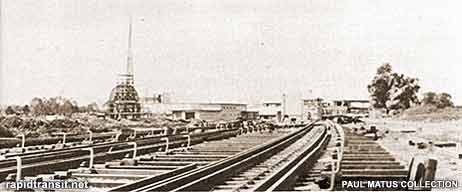 |
||||||||||||
 |
||||||||||||
|
Page 3 |
||||||||||||
 |
||||||||||||
|
Belmont's liability was finally lifted from him in 1913 when the City purchased the tunnels from Belmont for reconstruction as a part of the Dual Contract network. Extensively rebuilt for use by rapid transit stock, the torturous trail to operation finally ended when the line was opened in 1915, between Grand Central Station and Vernon-Jackson Avenues. Rapid Transit for Queens Queens, the largest of the city's five boroughs in land area, was well behind her sister boroughs in population—and the gap was widening. She had no expansive IRT, nor a home-grown Prometheus, as did Brooklyn. Communities grew round rapid transit lines and Queens, without rapid transit, found her growth stunted. The provisions of the Dual Contracts began to remedy this lack. The line to Jamaica, first proposed by the BRT in 1911 as an extension of the Eastern Parkway subway (which went to the IRT), was to be built out of the immense junction at Broadway Junction, where the Broadway, Canarsie, Cypress Hills and Fulton Street Lines met in a maze of trackwork rebuilt under a provision of the Dual Contracts. More important was the link provided by the lines to Corona and Astoria. The BRT's Broadway subway and the IRT's 2nd Avenue "L" (running over the Queensboro Bridge) and the Steinway operation would meet at Queensboro Plaza, just across the East River, there to operate the Astoria and Corona Lines as a joint operation. |
||||||||||||
|
In the autumn of 1938, the IND branch snaked toward the Trylon and Perisphere -- both rushing toward completion for the exhibition. This was the "World's Fair Railroad," built to high standards, charging an extra fare of ten cents, and torn up at the completion of the Fair. |
||||||||||||
|
While the BRT was busy burrowing under Broadway, the IRT, having to build only a couple of miles of extension trackage, began operation to Ditmars Avenue (now Boulevard), Astoria, on February 1, 1917, and to 103rd Street, Corona, three months later. By September, 1917, the BRT was no further up Broadway then 14th Street at Union Square. When, on August Ist, 1920, the BRT emerged at Queensboro Plaza, the landscape was not at all to its liking. The 2. 5 miles of track to Astoria and 4. 3 miles to Corona, with a total of seventeen station stops, had each and every platform built to accomodate the IRT's standard 9' width cars. The 67' cars which inaugurated the Sea Beach-Fourth Avenue service five years earlier had also been built to a 10' railroad coach width. And so was the Broadway Line up to Queensboro Plaza built for 10' wide cars. BRT "L" cars were 9' wide, but aside from the safety hazard for entraining passengers, the wooden gate cars had been banned from use in tunnels as a matter of City policy, partly to prevent a repetition of wrecks like that on the BRT's Brighton Line in 1918. Obviously, as long as the BRT was restricted to using 10' wide equipment and the Queens Lines platforms were sized for 9' IRT cars there would be no joint operation. |
The BRT confronted the problem head on and demanded that the IRT do something and, surprisingly, the IRT responded with a seemingly agreeable settlement: It would cut back the platforms and install gap fillers if the BRT would foot the bill. Perhaps the BRT was suffering from the unbroken string of victories it had enjoyed for nearly a decade, or it might have been that the BRT's bankruptcy and receivership did not allow them the luxury of such an expenditure, but the BRT refused the offer, took the matter to court and lost. It was not until 1923 and after the BRT had succumbed and become the Brooklyn-Manhattan Transit Corporation (BMT), that service was inaugurated by the Brooklyn transit company along the Queens lines. After all, the BMT had been forced to use the wooden "L" cars to provide service in an isolated operation, the Broadway subway passengers for Queens changing for the gate cars at Queensboro Plaza. In a brochure announcing the service the BMT called it "temporary." |
|||||||||||
|
Updated |
||||||||||||
|
©1966 Silver Leaf Rapid Transit. ©2000 The Composing Stack Inc. All right reserved |
||||||||||||